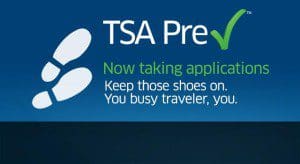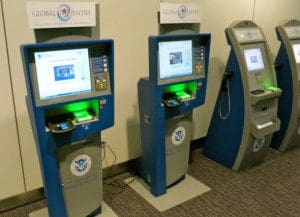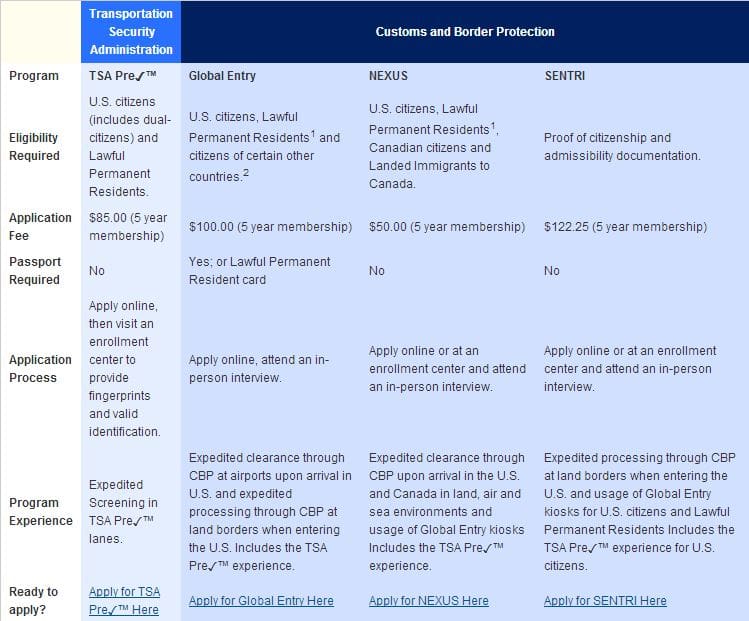 Department of Homeland Services (DHS) operates four separate Trusted Traveler programs designed to make the airport security process and entry into the U.S. more efficient for approved members. Each program has a different travel security focus, so we’ve compiled a comparison to help you determine which Trusted Traveler program is right for you. In addition, we’ve included a simple chart of the major features of each program for quick reference.
Department of Homeland Services (DHS) operates four separate Trusted Traveler programs designed to make the airport security process and entry into the U.S. more efficient for approved members. Each program has a different travel security focus, so we’ve compiled a comparison to help you determine which Trusted Traveler program is right for you. In addition, we’ve included a simple chart of the major features of each program for quick reference.
TSA Precheck or Pre✓™
 TSA Pre✓™ is an intelligence risk-based airport security process implemented by the Transportation Security Administration (TSA). It applies only to air travel within the U.S. The benefit to the traveler is expedited security screening through the TSA Pre✓™ lanes. Currently nineteen airlines participate in TSA Pre✓™ and operations are available at 180 U.S. airports. To be eligible, travelers must apply for a Known Traveler Number (KTN), and then visit an enrollment center to provide fingerprints and valid identification. The application fee is $85 for a five-year membership. Travelers are vetted for TSA Pre✓™ every time they fly and if cleared, information is embedded in the barcode of their boarding pass and the passenger may be directed to the TSA Pre✓™ security lanes. It’s important to note that eligibility does not guarantee expedited security processing, as that is always at TSA’s discretion. Children 12 and under traveling with the TSA Pre✓™ member are allowed to use the expedited security lanes also, but companions 13 and older who are not members themselves must use the regular security lanes.
TSA Pre✓™ is an intelligence risk-based airport security process implemented by the Transportation Security Administration (TSA). It applies only to air travel within the U.S. The benefit to the traveler is expedited security screening through the TSA Pre✓™ lanes. Currently nineteen airlines participate in TSA Pre✓™ and operations are available at 180 U.S. airports. To be eligible, travelers must apply for a Known Traveler Number (KTN), and then visit an enrollment center to provide fingerprints and valid identification. The application fee is $85 for a five-year membership. Travelers are vetted for TSA Pre✓™ every time they fly and if cleared, information is embedded in the barcode of their boarding pass and the passenger may be directed to the TSA Pre✓™ security lanes. It’s important to note that eligibility does not guarantee expedited security processing, as that is always at TSA’s discretion. Children 12 and under traveling with the TSA Pre✓™ member are allowed to use the expedited security lanes also, but companions 13 and older who are not members themselves must use the regular security lanes.
Global Entry

Photo credit: travelskills.com
Global Entry is a U.S. Customs and Border Protection (CBP) program that allows expedited clearance for pre-approved, low-risk travelers upon arrival in the United States. This Trusted Traveler program is best for frequent international travelers. Participants are allowed to enter the country by use of automated kiosks at select airports. The kiosks scan their machine-readable passport and verifies fingerprints, then accepts custom declarations. The Global Entry program requires a thorough background check and a personal interview at an enrollment center. The fee is $100 for a five-year membership. Participation includes the TSA Pre✓™ experience when applicable.
NEXUS
 NEXUS is a CBP program that gives United States and Canadian citizens border crossing privileges into the U.S. at air, land and seaports. This Trusted Traveler program is useful for those whose international travel is mainly between the U.S. and Canada. Members can use their NEXUS card or an iris scan as an alternative to a passport. Pre-screened travelers may use dedicated processing lanes to expedite passage and minimize customs and immigration questioning. Applications can be done online or at an enrollment center and require a personal interview. The fee is $50 for a five-year membership. Participation includes the use of Global Entry kiosks and TSA Pre✓™ when applicable.
NEXUS is a CBP program that gives United States and Canadian citizens border crossing privileges into the U.S. at air, land and seaports. This Trusted Traveler program is useful for those whose international travel is mainly between the U.S. and Canada. Members can use their NEXUS card or an iris scan as an alternative to a passport. Pre-screened travelers may use dedicated processing lanes to expedite passage and minimize customs and immigration questioning. Applications can be done online or at an enrollment center and require a personal interview. The fee is $50 for a five-year membership. Participation includes the use of Global Entry kiosks and TSA Pre✓™ when applicable.
SENTRI

Photo credit: sandiegored.com
Secure Electronic Network for Travelers Rapid Inspection (SENTRI) is useful for those who frequently commute between the U.S. and Mexico by vehicle. It provides expedited CBP processing for pre-approved, low-risk travelers from Mexico into the U.S. at 11 land border crossings in California, Arizona, and Texas. Members drive into the U.S. via a dedicated SENTRI lane. Their SENTRI card is a Radio Frequency Identification Document (RFID) that automatically pulls up the member’s data on the CBP officer’s computer screen. The officer verifies the information and the traveler is released for entry into the U.S. The cost is $122.25 for a five-year membership. Application must be made online. A rigorous background check is performed and an in-person interview is required for approval. Participation includes the use of Global Entry kiosks and TSA Pre✓™ when applicable.
Trusted Traveler Program Comparison Chart








So, isn’t Nexus always the best option for the money, since it includes TSA Pre and Global Entry, yet costs less than Global Entry and TSA Pre? Am I missing something? I am more concerned about flying, not driving, so Sentri doesn’t have much appeal to me.
Good question, David. The NEXUS card is really an alternate form of ID for U.S. travelers who are going to Canada and Mexico only. While the NEXUS card does offer Global Entry credentials, per U.S. Customs and Border Protection, “You cannot use your NEXUS card at Global Entry kiosks outside of Canadian Preclearance locations.” So if traveling to/from Europe, the Caribbean or any country other than Canada, Global Entry would still be the best. Hope that helps. 🙂
Apparently yes NEXUS is the best in terms of cost, and you can use the global entry kiosks regardless of where you come from. However the catch is that you need to interview at a NEXUS location, and there aren’t many of those, because the program is mainly for US/Canada travelers, all NEXUS locations are in the north close to the Canadian border, think NY, Maine, Washington, etc.. so if you can make it to the NEXUS office there then it’s definitely the best option